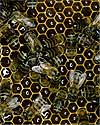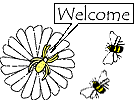 February 25, 2003
February 25, 2003
 Those clever spiders! Some spiders use sticky webs to trap a tasty meal.
Other spiders hide in the ground, and then pounce on unsuspecting prey.
Scientists have discovered a new way in which some spiders trap their
favorite food (honeybees). Australian crab-spiders (Thomisus
spectabilis) interfere with the ultraviolet signals on flowers to
attract honeybees.
Those clever spiders! Some spiders use sticky webs to trap a tasty meal.
Other spiders hide in the ground, and then pounce on unsuspecting prey.
Scientists have discovered a new way in which some spiders trap their
favorite food (honeybees). Australian crab-spiders (Thomisus
spectabilis) interfere with the ultraviolet signals on flowers to
attract honeybees.
 Humans, who cannot see ultraviolet signals, have a difficult time seeing
camouflaged Australian crab-spiders on the petals of the white daisy.
Honeybees, however, can see ultraviolet light and are attracted to the
patterns that spiders make on the flower petals. When given a choice
between landing on a flower with or without a spider, honeybees preferred
the flower WITH the spider about 80% of the time. Australian crab-spiders
apparently create a color pattern that bees find hard to resist. And
then...the spider has a tasty meal.
Humans, who cannot see ultraviolet signals, have a difficult time seeing
camouflaged Australian crab-spiders on the petals of the white daisy.
Honeybees, however, can see ultraviolet light and are attracted to the
patterns that spiders make on the flower petals. When given a choice
between landing on a flower with or without a spider, honeybees preferred
the flower WITH the spider about 80% of the time. Australian crab-spiders
apparently create a color pattern that bees find hard to resist. And
then...the spider has a tasty meal.
|


 February 25, 2003
February 25, 2003![[email]](./gif/menue.gif)



